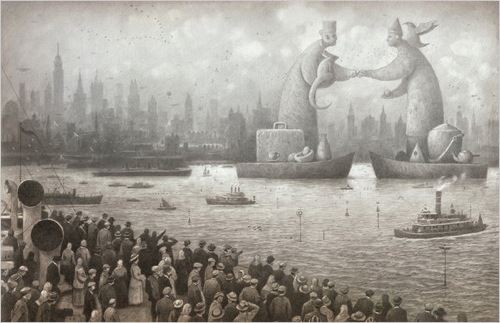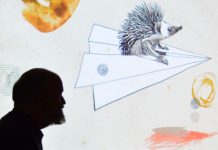Illustrator/animator/visual storyteller Shaun Tan gets profiled in the Sunday NY Times Magazine, the traditional anointing of a major creative figure.
Tan creates picture books, but he’s not a children’s author, exactly; “The Arrival” is a masterpiece of the graphic-novel form, but he’s not really a graphic novelist either. Chris van Allsburg, author of “The Polar Express” and other picture books that parents are happy to pore over repeatedly with their children, comes to mind as a peer, but the Japanese animator Hayao Miyazaki, perhaps best known for “Spirited Away,” might make a better comparison. Like Miyazaki, Tan engages audiences across a wide range of age and sophistication. I teach “The Arrival” in a graduate seminar on the city in literature, and my wife teaches it in an undergraduate course on immigrant narratives, but our daughters enjoyed it when they were kindergartners, and one of them, now 10, has recently been stealing “Lost and Found” from my desk. Tan’s low-key, open-ended, enigmatic stories are often about coming at a forbidding world from a fresh angle, making it strange on the way to making it one’s own — an experience that children share with immigrants and with artists.
Tan won an Oscar for his film THE LOST THING, based on his book of the same name, and though he’s currently negotiating a possible film based on THE ARRIVAL, he remains true to his native nedium:
He was also perhaps alone among Oscar nominees in preferring a book to his own filmed adaptation of it. “I’m proud of the movie we made,” he said, “but, without being immodest, I think that book is perfect. The film is a powerful experience, but there’s something about the book that nailed the slightly Asperger’s quality of the city.”
If you have never read THE ARRIVAL, which is wordless, it is indeed a masterpiece told entirely in haunting illustrations that capture the universal human drama of immigration and “otherness” and how it affects both people and cultures found and left behind.
THE ARRIVAL inhabits an elite neighborhood along with THE INVENTION OF HUGO CABRET and the Wimpy Kid books, that borders ComicsLand but isn’t entirely part of it. In his notes on creating THE ARRIVAL, Tan talks about whether it was a “graphic novel” or not, and if it does have that designation, it’s more by accidental evolution than by design:
Unwittingly, I had found myself working on a graphic novel rather than a picture book. There is not a great difference between the two, but in a graphic novel there is perhaps far more emphasis on continuity between multiple frames, actually closer in many ways to film-making than book illustration. I have never been a great reader of comics (having come at illustration as a painter) so much of my research was redirected to a study of different kinds of comics and graphic novels. What shapes are the panels? How many should be on a page? What is the best way to cut from one moment to the next? How is the pace of the narrative controlled, especially when there are no words? A useful reference was Understanding Comics by Scott McCloud, which details many aspects of ‘sequential art’ in a way that is both theoretical and practical, not least because it’s a textbook written as a comic – and very cleverly done. I noticed also that many Japanese comics (manga) use large tracts of silent narrative, and exploit a sense of visual timing that is slightly different from Western comics, which I found very instructive. Simultaneously, I had been working in some capacity as an animation director recently with a studio in London, adapting The Lost Thing as a short film (where much of the narrative is silent) and closely studying to the techniques used by storyboard artists and editors in that industry. All of these pieces of ‘research’ informed the style and structure of the book over several full-length revisions.








I have been crowing about The Arrival for years to all my comic friends. Unfortunately it always seems to fall on deaf ears. The book is a masterpiece.
The Tiki
I have been crowing about The Arrival for years to all my comic friends. Unfortunately it always seems to fall on deaf ears. The book is a masterpiece.
The Tiki
I have been crowing about The Arrival for years to all my comic friends. Unfortunately it always seems to fall on deaf ears. The book is a masterpiece.
The Tiki